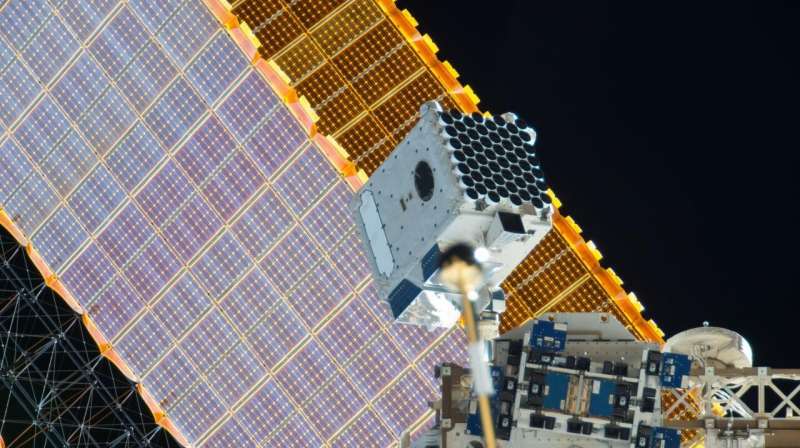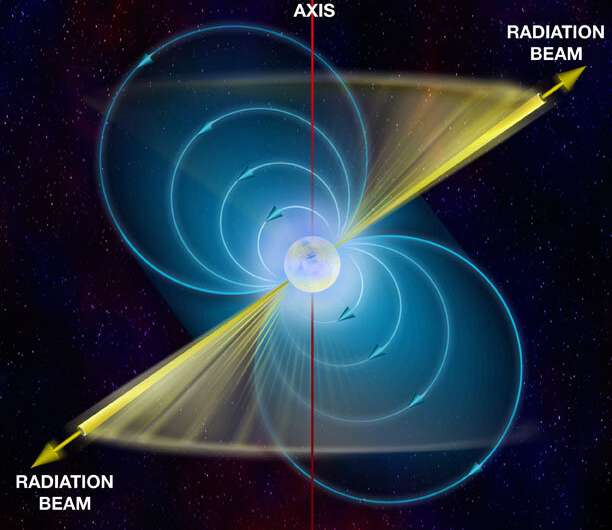Future space travelers may follow cosmic lighthouses

For centuries, lighthouses helped sailors navigate safely into harbor. Their lights swept across the water, cutting through fog and darkness, guiding mariners around dangerous obstacles and keeping them on the right path. In the future, space explorers may receive similar guidance from the steady signals created by pulsars.
Scientists and engineers are using the International Space Station to develop pulsar-based navigation using these cosmic lighthouses to assist with wayfinding on trips to the Moon under NASA's Artemis program and on future human missions to Mars.
Pulsars, or rapidly spinning neutron stars, are the extremely dense remains of stars that exploded as supernovas. They emit X-ray photons in bright, narrow beams that sweep the sky like a lighthouse as the stars spin. From a great distance they appear to pulse, hence the name pulsars.
An X-ray telescope on the exterior of the space station, the Neutron star Interior Composition Explorer or NICER, collects and timestamps the arrival of X-ray light from neutron stars across the sky. Software embedded in NICER, called the Station Explorer for X-ray Timing and Navigation Technology or SEXTANT, is using the beacons from pulsars to create a GPS-like system. This concept, often referred to as XNAV, could provide autonomous navigation throughout the solar system and beyond.
"GPS uses precisely synchronized signals. Pulsations from some neutron stars are very stable, some even as stable as terrestrial atomic clocks in the long term, which makes them potentially useful in a similar way," says Luke Winternitz, a researcher at NASA's Goddard Space Flight Center in Greenbelt, Maryland.
The stability of the pulses allows highly accurate predictions of their time of arrival to any reference point in the solar system. Scientists have developed detailed models that predict precisely when a pulse would arrive at, for example, the center of Earth. Timing the arrival of the pulse to a detector on a spacecraft, and comparing that to when it is predicted to arrive at a reference point, provides information for navigating far beyond our planet.
"Navigation information provided by pulsars does not degrade by moving away from Earth since pulsars are distributed throughout our Milky Way galaxy," says SEXTANT team member Munther Hassouneh, navigation technologist.
"It effectively turns the 'G' in GPS from Global to Galactic," adds team member Jason Mitchell, director of the Advanced Communications and Navigation Technology Division in NASA's Space Communication and Navigation Program. "It could work anywhere in the solar system and even carry robotic or crewed systems beyond the solar system."
Pulsars also can be observed in the radio band but, unlike radio waves, X-rays are not delayed by matter in space. Additionally, detectors for X-rays can be more compact and smaller than radio dishes.
But because X-ray pulses are very weak, a system must be robust enough to collect a signal sufficient for navigating. NICER's large collection area makes it nearly ideal for XNAV research. A future XNAV system could be made smaller, trading size for longer collection time.

"NICER is roughly the size of a washing machine, but you could dramatically reduce its size and volume," Mitchell says. "For example, it would be interesting to fit an XNAV telescope into a small satellite that could independently navigate the asteroid belt and characterize primitive solar system bodies."
As published in a 2018 paper, SEXTANT already has successfully demonstrated real-time pulsar-based navigation aboard the space station. It also studied the use of pulsars for time-keeping and clock synchronization and is helping expand the catalog of pulsars to use as reference points for XNAV.
The SEXTANT team also includes Samuel Price, Sean Semper and Wayne Yu at Goddard; Naval Research Lab partners Paul Ray and Kent Wood; and NICER principal investigator Keith Gendreau and science lead Zaven Arzoumanian.
The team now is studying XNAV autonomous navigation on NASA's Gateway platform as a technique to support crewed missions to Mars. Astronauts also could potentially use it to supplement onboard navigation capabilities should they need to make it back to Earth on their own.
"Gateway's orbit around the Moon of approximately six-and-a-half days would let us stare at pulsars for much longer times," Mitchell says. "That's where the trade comes in; the instrument is like a bucket and you're filling that bucket with enough X-ray photons to generate a measurement of when that pulse arrived. You could have a detector a fraction the size of NICER."
These kinds of experiments could bring cosmic lighthouses to guide spacecraft to their destinations another step closer to reality.
Provided by NASA





















